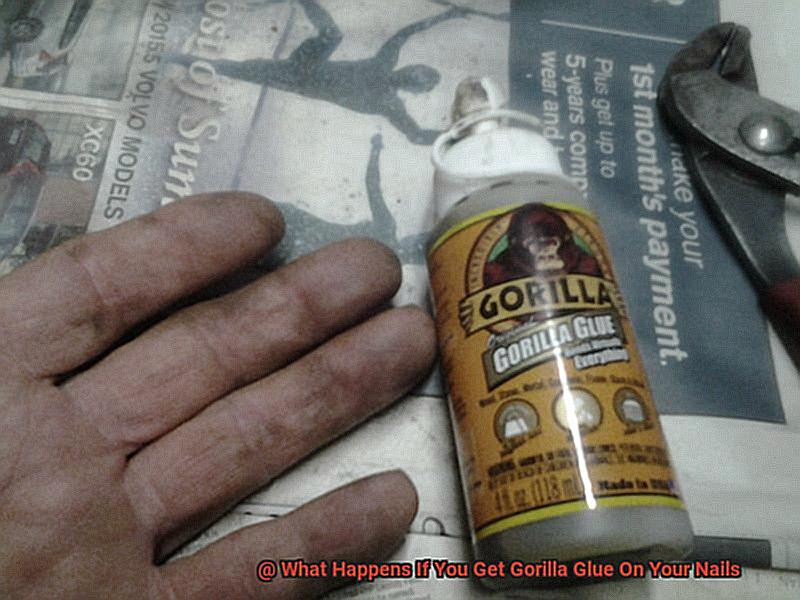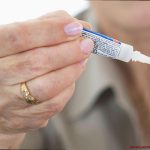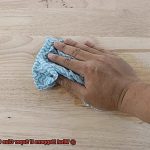Ever had one of those clumsy moments where some random substance decides to make a beeline for your precious nails? Paint, super glue, or even the mighty Gorilla Glue – it’s like they have a magnetic attraction to our manicures. But fear not. Today, we’re diving headfirst into the sticky world of Gorilla Glue and its impact on our delicate nails.
Whether you’re a DIY enthusiast or just plain curious about the mishaps we sometimes find ourselves in, buckle up as we unravel the potential outcomes of crossing paths with this industrial-strength adhesive.
In this blog post, we’ll explore all the unique properties of Gorilla Glue, from its mind-boggling adhesive strength to how it can potentially wreak havoc on our beautifully manicured nails. We’ll dish out some essential do’s and don’ts to ensure your nails stay flawless. Accidents happen to the best of us, but arming yourself with knowledge about the potential consequences will make you feel like a pro when handling these sticky situations.
So grab your virtual toolbelt and let’s uncover the nitty-gritty details of Gorilla Glue’s interaction with our beloved nails. Whether you’re looking to prevent a sticky disaster or seeking guidance for fixing a glue-related mishap, consider us your trusty guides.
Join us on this intriguing journey into the world of nail care and adhesive mishaps – by the end of this post, you’ll be ready to tackle any sticky situation that comes your way like a true pro.
What Is Gorilla Glue?
Contents
- 1 What Is Gorilla Glue?
- 2 How Does Gorilla Glue Affect Your Nails?
- 3 What Are the Risks of Using Gorilla Glue on Your Nails?
- 4 How to Remove Gorilla Glue from Your Nails
- 5 Home Remedies for Removing Gorilla Glue from Your Nails
- 6 Professional Help for Removing Gorilla Glue from Your Nails
- 7 Preventing Accidental Contact with Gorilla Glue on Your Nails
- 8 Conclusion
Gorilla Glue, a popular adhesive known for its strength and versatility, is a game-changer in the world of bonding. Whether you’re tackling a home improvement project or repairing a cherished item, this polyurethane glue has got your back. It forms an unbreakable bond between various materials such as wood, metal, fabric, ceramic, and more, making it a go-to adhesive for many.
One of Gorilla Glue’s standout features is its remarkable bonding strength. Designed to withstand heavy-duty applications, this adhesive creates a durable and long-lasting bond that can weather the storm. Its secret lies in polyurethane, which allows the glue to expand as it cures, filling in gaps and creating a tight bond. This makes it particularly effective for porous surfaces or materials with irregular shapes.
Gorilla Glue comes in different forms to cater to your specific bonding needs. The original version is a thick, amber-colored liquid that requires moisture to activate. It’s ideal for bonding dissimilar surfaces and can be used both indoors and outdoors. If you’re working with wood, there’s even a specialized Gorilla Wood Glue formulated just for that purpose.
In addition to its strength, Gorilla Glue is also water-resistant once fully cured. This means it can hold its own against moisture without compromising its adhesive properties. However, prolonged exposure to water may weaken the bond over time, so it’s best to exercise caution.
To get the most out of Gorilla Glue, following the manufacturer’s instructions is crucial. Applying a thin layer of glue on the surfaces to be bonded and clamping them together until the glue sets will ensure optimal bond strength. It’s important to handle Gorilla Glue with care and avoid contact with skin since it can be quite stubborn to remove once cured.
How Does Gorilla Glue Affect Your Nails?
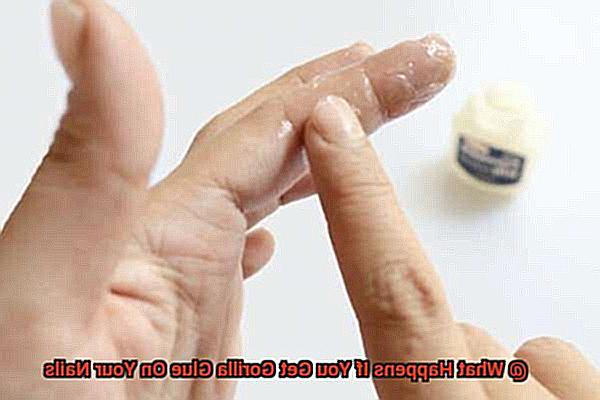
Gorilla Glue, renowned for its strength and durability, may be a superhero in the world of adhesives, but it is not a friend to your nails. This powerful adhesive, not intended for nail use, can have several negative effects that you need to be aware of.
Firstly, Gorilla Glue can cause significant damage to the delicate nail bed and surrounding skin. When it bonds tightly to the nail, removing it becomes quite a challenge without causing further harm. Attempting to pry or scrape off the glue can lead to painful peeling and even breakage of the nail itself.
Moreover, the chemicals in Gorilla Glue can make your nails brittle and weak. By stripping away moisture from the nails, the glue leaves them dry and susceptible to cracking. This results in unsightly and uncomfortable nail problems such as splitting and peeling.
If Gorilla Glue comes into contact with the skin surrounding the nail, irritation and redness are likely to occur. In some cases, individuals may experience an allergic reaction to the glue, causing itching, swelling, and discomfort.
Should you find yourself in a sticky situation with Gorilla Glue on your nails, it is crucial to take immediate action to minimize damage and ensure proper healing. Seek professional advice or consult a nail technician who can guide you on safe removal techniques.
What Are the Risks of Using Gorilla Glue on Your Nails?
Gorilla Glue may be a popular choice for DIY projects, but when it comes to your nails, it’s best to steer clear. Using Gorilla Glue on your nails can have numerous risks and potential dangers. Here are some important factors to consider:
- Damage to the nail bed: Gorilla Glue is designed to create a strong bond, but this strength can cause damage to your nail bed. The adhesive can make your nails brittle, weak, and more prone to breakage. This can lead to painful and unsightly conditions like nail splitting or lifting.
- Skin irritation and allergic reactions: Gorilla Glue contains chemical compounds that can cause skin irritation or allergic reactions. If the glue comes into contact with the sensitive skin around your nail bed, you may experience redness, itching, or even an allergic reaction.
- Interference with nail care: Using Gorilla Glue on your nails can interfere with proper nail care and maintenance. The glue is not designed for use on nails, so it may prevent you from cleaning, filing, and shaping them effectively. This can result in poor nail health and hygiene.
- Difficulty in removing the glue: Removing Gorilla Glue from your nails can be challenging and may require aggressive methods that further damage your nails. Using excessive force or harsh chemicals to remove the glue can cause thinning, peeling, or even complete loss of the nail plate.
- Professional recommendations: Professionals in the beauty and nail care industry do not recommend using Gorilla Glue on your nails. There are specific products available that are designed for nail enhancements and extensions, which are much safer and more suitable for use on nails.
If you accidentally get Gorilla Glue on your nails, it’s important to seek immediate professional advice from a nail technician or healthcare professional. They can guide you on the best course of action to minimize any potential damage and safely remove the glue from your nails.
How to Remove Gorilla Glue from Your Nails
Accidentally getting Gorilla Glue on your nails can be a frustrating and challenging situation, but it is not impossible to remove. With the right approach and supplies, you can effectively remove the glue and restore your nails’ natural beauty. Follow these steps:
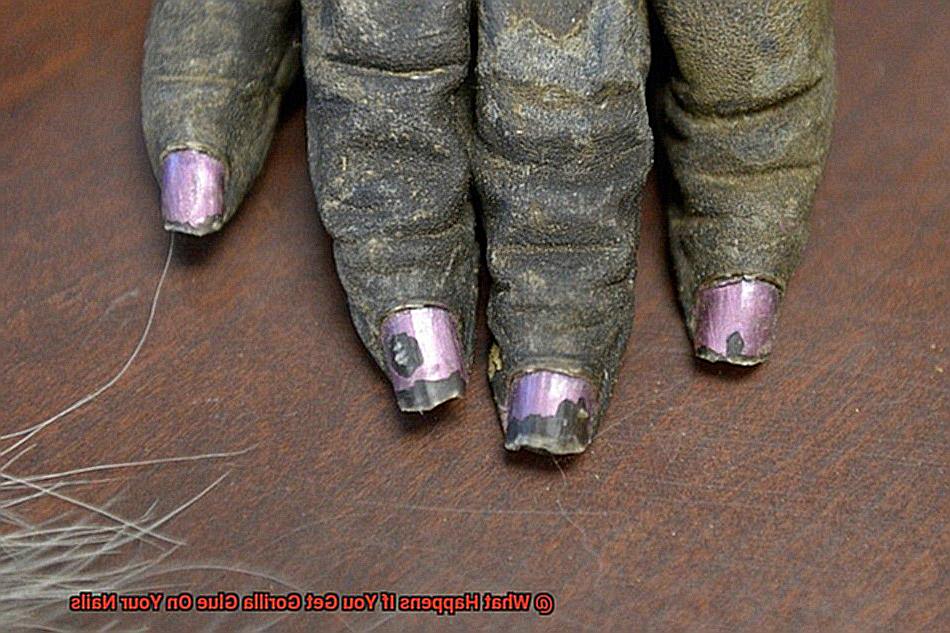
- Act quickly: The first step in removing Gorilla Glue from your nails is to act quickly. The glue can dry and harden rapidly, making it more difficult to remove. As soon as you notice the glue on your nails, take immediate action.
- Gather necessary supplies: Before starting the removal process, gather the following supplies: acetone-based nail polish remover, cotton balls or pads, a nail file or buffer, a cuticle pusher, and moisturizing lotion or oil.
- Soak nails in warm soapy water: Start by soaking your nails in warm soapy water for about 10 minutes. This will help soften the glue and make it easier to remove.
- Use acetone-based nail polish remover: If soaking your nails in warm soapy water doesn’t fully remove the Gorilla Glue, it’s time to bring out the acetone-based nail polish remover. Soak a cotton ball or pad in the remover and place it on your nail. Wrap your nail in aluminum foil or a plastic bag to keep the remover in contact with the glue. Leave it on for about 10-15 minutes.
-
Gently scrub off glue: After removing the foil or bag, gently scrub off the softened Gorilla Glue using a cotton ball or pad soaked in acetone-based nail polish remover. Be careful not to apply excessive pressure or use sharp tools that could damage your nails.
- File and buff nails: If there are any remnants of Gorilla Glue left on your nails after scrubbing, use a nail file or buffer to gently remove them. Take care not to file too aggressively, as this can weaken and damage your nails.
- Push back cuticles: To ensure thorough removal of Gorilla Glue, gently push back your cuticles using a cuticle pusher or orange stick. This will help access any glue that may have seeped underneath the nail edges.
- Moisturize and protect: After successfully removing the Gorilla Glue from your nails, it’s important to moisturize and protect them. Apply a generous amount of moisturizing lotion or oil to nourish and hydrate your nails and cuticles.
- Avoid picking or peeling: Lastly, resist the temptation to pick or peel off any remaining Gorilla Glue. Doing so can cause damage to your nails and may lead to further complications.
Remember, the removal process may vary depending on the severity of the Gorilla Glue application. If you encounter any difficulties or are unsure about the best approach, it’s advisable to seek professional help from a nail technician or dermatologist.
Home Remedies for Removing Gorilla Glue from Your Nails
Removing Gorilla Glue from your nails can be a daunting task, but fear not. There are several effective home remedies that can help you get rid of the glue without causing any harm to your nails. Let’s explore these remedies in detail:
- Acetone Method: Acetone is the go-to ingredient for removing stubborn adhesives, and it works wonders on Gorilla Glue too. Soak a cotton ball or pad in acetone and place it directly on the affected area. Secure it with a bandage or adhesive tape to keep it in place. Leave it on for about 10-15 minutes to allow the glue to soften and loosen.
Then, gently rub the cotton ball over your nails in circular motions to remove the softened glue. Be careful not to scrape or forcefully remove the glue, as this can damage your nails. If there are still remnants of Gorilla Glue on your nails, repeat the process with a fresh acetone-soaked cotton ball until all traces of the glue are gone.
- Warm Soapy Water Method: This method is simple yet effective. Soak your nails in warm soapy water for about 10-15 minutes to soften the glue. After soaking, use a gentle nail brush or an old toothbrush to gently scrub away the softened glue from your nails. Be cautious not to apply too much pressure, as this can cause damage. Rinse your nails with clean water and pat them dry.
- Oil Method: If you prefer a natural approach, you can try using olive oil or coconut oil to dissolve Gorilla Glue. Apply a small amount of oil onto a cotton ball and gently rub it over the glue until it starts to dissolve. Wipe away any residue with a clean cloth.
Remember, these home remedies may require multiple attempts and patience to completely remove Gorilla Glue from your nails. If you’re unable to remove it, it’s best to seek professional help from a nail technician or dermatologist. Additionally, to prevent future accidents, always wear gloves when handling strong adhesives and follow the instructions provided by the manufacturer.
Professional Help for Removing Gorilla Glue from Your Nails
When it comes to removing Gorilla Glue from your nails, seeking professional help is the way to go. DIY removal methods can be risky and potentially damaging to your nails, so it’s best to leave it to the experts. Nail technicians or manicurists have the knowledge and experience to safely remove Gorilla Glue without causing harm.
One common method used by professionals is soaking the affected nails in acetone. Acetone is a powerful solvent that can break down the bond of the glue, making it easier to remove. The process involves soaking cotton balls or pads in acetone and placing them on the affected nails. The nails are then wrapped in foil or plastic wrap to prevent the acetone from evaporating. This allows the glue to soften and loosen its grip on the nails.
After a certain period of soaking, typically around 15-20 minutes, the nail technician will gently scrape off the softened glue using a wooden or metal cuticle pusher. It’s important to use proper tools and techniques to avoid damaging the natural surface of the nail. Depending on the severity of the glue residue, multiple soaking and scraping sessions may be required to completely remove the Gorilla Glue.
Once all the glue has been successfully removed, the nail technician will proceed with regular nail care procedures like trimming, shaping, and moisturizing the nails and cuticles. They may also provide aftercare instructions, such as avoiding excessive filing or buffing of the nails for some time to allow them to fully recover.
Remember, prevention is always better than cure. Exercise caution when using Gorilla Glue or any other strong adhesive to avoid accidental spills or contact with your nails. However, if you do find yourself in a situation where Gorilla Glue has come into contact with your nails, it’s best to act quickly and seek professional assistance as soon as possible to prevent further complications.
Preventing Accidental Contact with Gorilla Glue on Your Nails
Preventing accidental contact with Gorilla Glue on your nails is crucial to avoid potential damage and maintain the health of your nails. Gorilla Glue is a powerful adhesive known for its strong bond and durability, but it is not meant to be used on human nails and can cause serious harm if it comes into contact with them. Here are some effective tips to help you prevent this sticky situation and keep your nails safe.
- Wear gloves: Whenever you are working with Gorilla Glue or any strong adhesive, wearing gloves is the first line of defense. Gloves provide a physical barrier between the glue and your nails, preventing any accidental spills or splatters from coming into contact with them. Choose gloves made of a material that is resistant to chemicals and ensure they fit properly for maximum protection.
- Use a barrier cream: In addition to wearing gloves, using a barrier cream on your hands and nails before working with Gorilla Glue can provide an extra layer of protection. Barrier creams create a protective layer on your skin that prevents the glue from adhering to it. Apply the cream generously and ensure it covers all areas where accidental contact could occur.
- Be cautious during handling: When using Gorilla Glue, be mindful of where you place your hands and nails. Keep your nails away from the glue bottle or tube and be aware of any potential drips or spills. It’s easy for accidents to happen, so consider covering your nails with tape or bandages as an additional precautionary measure if you are working on a project involving Gorilla Glue.
- Proper storage: Properly storing Gorilla Glue is essential to minimize the risk of accidental spills or misuse. Store the glue in a secure place, away from children and pets, ensuring it is stored upright and tightly closed after each use. This will help prevent any leaks or spills that could potentially come into contact with your nails.
In the event that you accidentally get Gorilla Glue on your nails, it’s important not to panic. Take immediate action to remove the glue before it fully dries and hardens. One common method is soaking your nails in warm soapy water for about 15-20 minutes to loosen the glue. After soaking, gently scrub your nails with a soft-bristled brush or a nail file to remove any residue.
However, attempting to forcibly remove dried Gorilla Glue from your nails can cause further damage. This can lead to peeling or even breaking of the nails, which can be painful and may require professional intervention. If you are unable to remove the glue using home remedies, it is advisable to seek assistance from a nail technician or a medical professional who can safely remove the glue without causing harm to your nails.
4tfblOx5rQk” >
Also Read: How do you remove dried Gorilla Glue?
Conclusion
In conclusion, the repercussions of getting Gorilla Glue on your nails are far from desirable. This formidable adhesive, renowned for its unyielding strength and durability, should never come into contact with your nails as it can wreak havoc on them.
The primary issue lies in the Herculean task of removing the glue once it forms an unbreakable bond with your nails. Any attempts to forcefully pry or scrape off the glue will inevitably result in excruciating pain and potential nail breakage. Moreover, the chemicals present in Gorilla Glue have a knack for rendering your nails brittle and feeble, making them susceptible to unsightly cracks and other nail-related predicaments.
Furthermore, if even a smidgen of Gorilla Glue touches the skin surrounding your nails, brace yourself for irritation and redness galore. In more severe cases, some unfortunate souls may even experience an allergic reaction that brings along incessant itching, swelling, and discomfort.
To salvage what remains of your once-flawless nails and ensure proper healing if you find yourself entangled in this sticky mess, it is absolutely imperative to seek immediate counsel from a seasoned nail technician or healthcare professional. These experts possess the wisdom and expertise needed to guide you through safe removal techniques tailored specifically to your unique situation.
Remember: prevention always trumps cure when it comes to safeguarding your precious nails against Gorilla Glue mishaps. Donning protective gloves, employing a trusty barrier cream, exercising utmost caution during handling, and storing the adhesive properly are all indispensable measures that must be taken to avoid any inadvertent encounters.
Let us not forget that entrusting professionals with the task of removing Gorilla Glue from your nails is an absolute no-brainer. DIY methods can prove perilous and potentially cause irreparable damage. Nail technicians boast the necessary know-how and experience to extract the glue without inflicting harm on your delicate digits.

